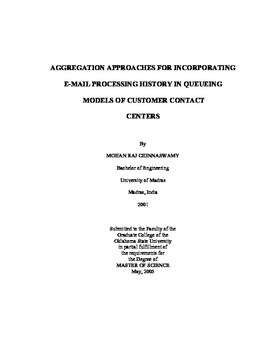| dc.contributor.advisor | Kamath, Manjunath | |
| dc.contributor.author | Chinnaswamy, Mohan Raj | |
| dc.date.accessioned | 2014-04-17T19:44:35Z | |
| dc.date.available | 2014-04-17T19:44:35Z | |
| dc.date.issued | 2005-05-01 | |
| dc.identifier.uri | https://hdl.handle.net/11244/9848 | |
| dc.description.abstract | The operation of a customer contact center where the interface between the agents' and the customer happens through e-mail was modeled using a multi-class open queueing network model. A novel approach to model the dependence of processing times and routing on e-mail history called the history-based aggregation method was developed. This aggregation method extends the popular parametric decomposition (PD) method for solving multi-class open queueing networks to more general situations. A discrete-time Markov chain (DTMC) with an expanded state space was developed to model the non-Markovian routing of a new e-mail through the contact center until its eventual resolution. The analysis of this absorbing Markov chain led to the computation of the proportion of e-mails in an agent's in-box that are new, previously processed by the same agent, or previously processed by another agent. Using these proportions, a new "history-based" aggregation step for each customer class in the PD method was introduced. This step precedes the existing class-based aggregation step in the PD method. The resulting queueing network model was solved using the RAQS software package. The accuracy and robustness of the analytical approach was demonstrated by comparing the analytical results with simulation estimates of performance measures for a variety of scenarios. Typical contact center situations like grouping of agents and server interruptions were also modeled within the above approach. The DTMC-based analytical method showed excellent prediction capability across the various cased examined. The relative percentage error in utilization was less than 1% in all cases and less than 17% for other performance measures. This work has laid the foundation for the development of rapid performance analysis tools for customer contact centers which can be effectively used for improving customer contact center operations. The history-based aggregation method represents a significant extension to the PD method for solving queueing network models. | |
| dc.format | application/pdf | |
| dc.language | en_US | |
| dc.publisher | Oklahoma State University | |
| dc.rights | Copyright is held by the author who has granted the Oklahoma State University Library the non-exclusive right to share this material in its institutional repository. Contact Digital Library Services at lib-dls@okstate.edu or 405-744-9161 for the permission policy on the use, reproduction or distribution of this material. | |
| dc.title | Aggregation Approaches for Incorporating E-mail Processing History in Queueing Models of Customer Contact Centers | |
| dc.type | text | |
| dc.contributor.committeeMember | Pratt, David B. | |
| dc.contributor.committeeMember | Sharda, Ramesh | |
| osu.filename | Chinnaswamy_okstate_0664M_1244.pdf | |
| osu.college | Engineering, Architecture, and Technology | |
| osu.accesstype | Open Access | |
| dc.description.department | Industrial Engineering & Management | |
| dc.type.genre | Thesis | |
